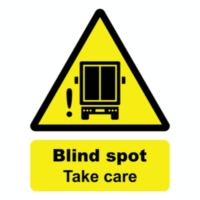Who’s at Fault in a Blind Spot Truck Accident?

A large percentage of truck accidents occur because car drivers and motorcyclists linger in the truck’s blind spots. While trucking companies often blame other drivers for a blind spot truck accident, the truck driver may also be at fault for the collision.
Truck drivers can be liable for this type of accident due to their failure to ensure that no one is in their blind spots before changing lanes or turning.
If you have been involved in a truck accident caused by blind spots, you should consult with a Miami truck accident lawyer to determine fault in your particular situation.
Where Are the Truck’s Blind Spots?
Since every car driver has to share the road with trucks, it is critical to know the location of the blind spots on a truck. The size and location of the blind spot vary from one vehicle to another and depend on:
- The type of the truck; and
- The size of the truck.
Tractor-trailers (18-wheelers) tend to have the biggest blind spots among all trucks. The truck’s blind spots are usually located in the spaces around the vehicle:
- The front blind spot. About 20 feet in the front area of the cab.
- The back blind spot. Trucks do not have rear-view mirrors, which means truck drivers cannot see what is happening behind the truck.
- The left blind spot. The no-zone begins below the driver side’s window and stretches back the length of the trailer.
- The right blind spot. The no-zone begins below the passenger side’s window and spans the length of the vehicle, extending out as wide as three lanes of traffic.
As its name implies, a blind spot means that the truck driver cannot see other vehicles in these danger zones. For this reason, truck drivers must use side mirrors and ensure that no one is lingering in the blind spots before executing any maneuvers on the road.
Who is at Fault When a Blind Spot Truck Accident Occurs?
In Florida, determining fault is not as crucial as in other states with at-fault insurance laws. That is because Florida is a no-fault insurance state, which means an injured car driver is entitled to compensation regardless of fault.
Note: Florida legislators could repeal the no-fault insurance system by Jan. 1, 2022.
Even though you are not required to prove the other party’s fault to recover damages, fault may still matter when you suffer serious injuries. Florida’s Personal Injury Protection (PIP) coverage offers an injured party up to $10,000 in medical bills and lost wages.
For this reason, if you suffered a serious or catastrophic injury, the cost of your medical treatment could exceed the PIP limits, not to mention that PIP benefits do not cover your non-economic damages.
That is why it may be necessary to determine fault in your blind spot truck accident. Determining liability for a truck crash involving blind zones is difficult because both parties may be to blame for the collision.
The car driver may be responsible for the accident because they lingered in the truck’s blind spot too long, while the trucker may be at fault for failing to clear their blind spots before changing lanes or turning.
It is advisable to consult with an experienced lawyer to determine fault in your blind spot truck accident. Schedule a consultation with our Miami truck accident attorneys at Pita Weber Del Prado by calling 305-670-2889.



